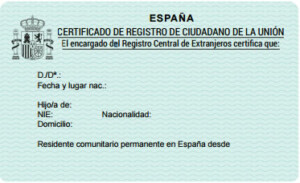Residency in Spain. If you live more than 183 days in Spain per year you are required to become a Spanish resident. EU citizens don`t need to apply for a ‘residence card’, all those coming to live in Spain are required to register themselves as resident by applying for a “Certificado de Registro” from Foreigner’s Office within three months of their arrival to Spain. Everything you need to know to apply for residency in Spain.
Experiencing the wonderful life that Spain offers expats worldwide requires just one thing: getting the residency and becoming a legal individual in the country.This guide explains the registration processes you must complete obtain your residency in Spain. You must register both on the central register of foreign nationals (‘registro central de extranjeros’) and with your local town hall (‘padrón municipal’). Children must also be registered on both systems.
How to get Spanish residency?

The certificate is valid indefinitely. If you live in Spain continuously for more than five years, you can opt for permanent residency.
Documentation required for applying for Spanish residency
The exact requirements for required for applying for Spanish residency will depend on the region in which you wish to live, as well as your own status. For example, depending on whether you are a pensioner, an early retiree or if you are working in Spain, there will be slightly different documents needed. However, the information below gives a general guide to what you will require.
What paperwork you need to obtain Spanish Residency Your NIE. The form S1 if you are a pensioner or proof of health insurance if not. Confirmation of payment for the residency in the bank. The completed residency application form. Passport. Proof of income. The recommendation is to always bring the original and a copy of each document in the list above.
#1 A valid passport or official identification.
#2 NIE – The NIE is a tax identification number in Spain, known in Spanish as the NIE, or more formally the Número de identidad de extranjero. If you are moving to Spain or have any economic, professional or family connection with the nation, you will need to apply for a Número de Identidad de Extranjero, or an NIE – which is a Foreigners’ Identification Number. Similarly to a National Insurance number, your NIE number is an all-purpose identification number for taxes and social security, but specifically for foreign nationals.
#3 Completed form Form EX-18 or Form Ex-19.
#4 Padron – Certificado de Empadronamiento from the Town Hall where you live. The padrón is the certificate that enables you to apply for a SIP (health card) and other local benefits within your town, such as enrolling your child in a local school, obtaining a bus pass, or using the local library. Read more about Padron in Costa Blanca.
#5 Proof of income – You must be able to demonstrate that your life in Spain is financially sustainable. You will be expected to show bank statements that cover the previous three months and that you have a monthly income of above €800 per person. If you have come to Spain to work then your employer should provide you with un certificado de vida laboral – which is proof that you have work here.
#6 The form S1 if you are a pensioner or proof of health insurance if not. If you are under pensionable age, then you must have proof of Spanish health insurance if you are not going to work. The insurance must be fully comprehensive and you may also need to show proof of payment.
#7 Passport photos and copies of the above. The recommendation is to always bring the original and a copy of each document in the list above.
Benefits Spanish residency
Obtaining Residency in Spain will give you a number of benefits. Below we have listed a few of them.
Destinations Spanish Residency
Alicante – Alcalali – Altea – Albir – Alfaz del Pi – Benissa – Benidorm – Benidoleig – Benilloba – Benitachell – Calpe – Costa Blanca – Costa Blanca North – Cumbre del Sol – Denia – El Vergel – Gata de Gorgos – Finestrat – Javea – Jalon – La Nucia – Lliber – Moraira – Parcent – Pedreguer – Orba – Polop – Teulada – Villajoyosa




